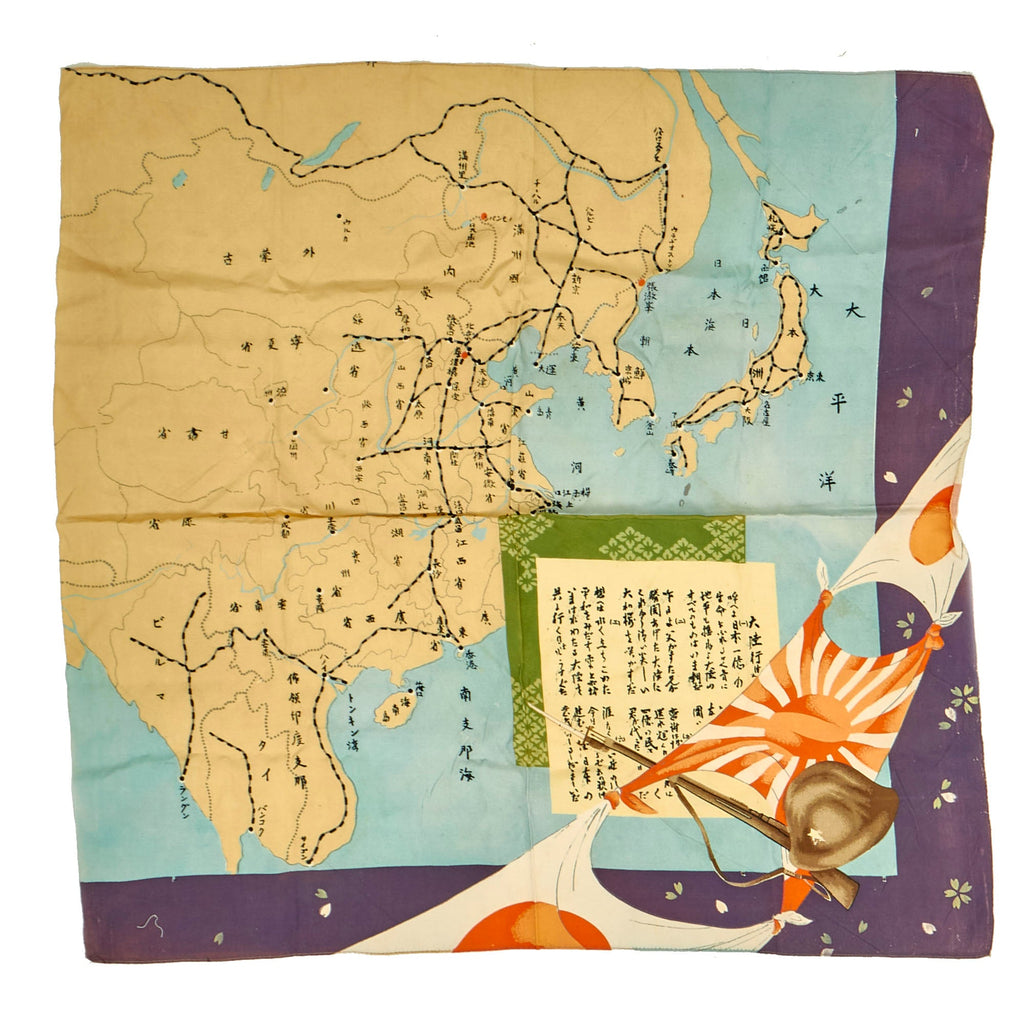Item Description
Original Item: Only One Available. This is an interesting yet wonderful cloth “silk” type map that appears to be a railroad commemorative map for the “Old Great Imperial Empire of Japan”. The map lists what appears to be railroads, as well as the countries of Mongolia, Manchuria, Japan, China Republic and most of SouthEast Asia with cities marked, all in Kanji. In the lower right hand corner is a “Song of Travel To China” though we have not been able to find exactly what song or poem this section is referring to, making for an excellent research and translation project.
The overall condition is quite nice with minimal staining, very few tears and a general wrinkled appearance from many years of storage while being folded. The map comes with a printed out picture of the flag with a few areas of Kanji translate, though we cannot confirm its accuracy.
A lovely map that comes more than ready for further research and display.
The Empire of Japan, also referred to as the Japanese Empire, Imperial Japan, or simply Japan, was the Japanese nation-state[ that existed from the Meiji Restoration in 1868 until the enactment of the reformed Constitution of Japan in 1947. From 29 August 1910 until 2 September 1945, it administered the naichi (the Japanese archipelago and post-1943 Karafuto) and the gaichi (Korea, Taiwan, Kwantung Leased Territory, and pre-1943 Karafuto). The South Seas Mandate was a mandate of the League of Nations under Japanese administration. In the closing stages of World War II, with Japan defeated alongside the rest of the Axis, the formalized Japanese Instrument of Surrender was issued in compliance with the Potsdam Declaration of the victorious Allies, and Japanese de facto territory subsequently shrunk to cover only the Japanese archipelago as it is today.
Under the slogans of fukoku kyōhei and shokusan kōgyō, which followed the Boshin War and the restoration of power to the Emperor from the Shogun, Japan underwent a period of large-scale industrialization and militarization, often regarded as the fastest modernization of any country to date. All of these aspects contributed to Japan's emergence as a great power following the First Sino-Japanese War, the Boxer Rebellion, the Russo-Japanese War, and World War I. Economic and political turmoil in the 1920s, including the Great Depression, led to the rise of militarism, nationalism, and totalitarianism, as embodied in Shōwa Statism. This ideological shift eventually culminated in Japan joining the Axis alliance with NSDAP Germany and Fascist Italy, and also conquering a large part of the Asia-Pacific.
The Imperial Japanese Armed Forces initially achieved large-scale military successes during the Second Sino-Japanese War and the Pacific War. However, from 1942 onwards, and particularly after decisive Allied advances at Midway Atoll and Guadalcanal, Japan was forced to adopt a defensive stance against the United States. The American-led island-hopping campaign led to the eventual loss of many of Japan's Oceanian island possessions in the following three years. Eventually, the American military captured Iwo Jima and Okinawa Island, leaving the Japanese mainland unprotected and without a significant naval defense force. By August 1945, plans had been made for an Allied invasion of mainland Japan, but were shelved after Japan surrendered in the face of a major breakthrough by the United States and the Soviet Union, with the former detonating two atomic bombs over Hiroshima and Nagasaki and the latter invading Japan's northern territories. The Pacific War officially came to an end on 2 September 1945, leading to the beginning of the Allied occupation of Japan, during which American military leader Douglas MacArthur administered the country. In 1947, through Allied efforts, a new Japanese constitution was enacted, officially ending the Japanese Empire and forming present-day Japan. During this time, the Imperial Japanese Armed Forces were dissolved and replaced by the current Japan Self-Defense Forces. Reconstruction under the Allied occupation continued until 1952, consolidating the modern Japanese constitutional monarchy.
In total, the Empire of Japan had three emperors, given posthumous names: Meiji, Taishō, and Shōwa. The Imperial era came to an end partway through Shōwa's reign, though he remained emperor until 1989.
- This product is available for international shipping.
- Eligible for all payments - Visa, Mastercard, Discover, AMEX, Paypal & Sezzle










